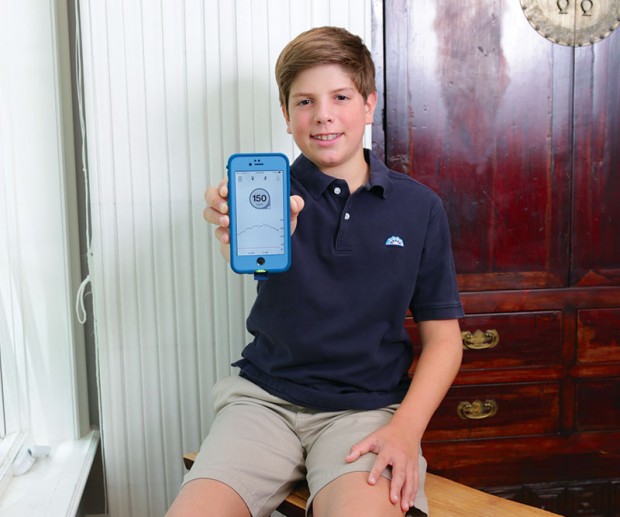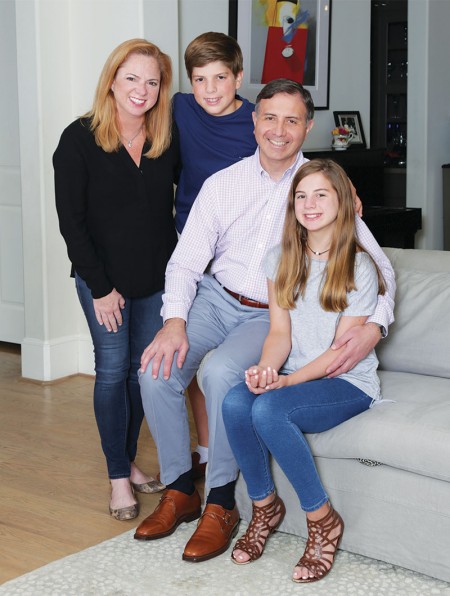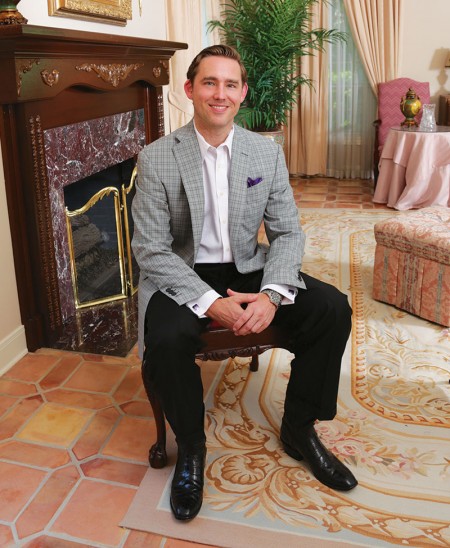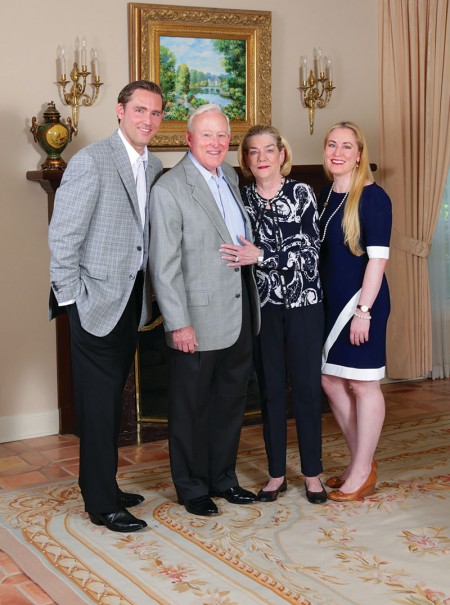Tackling Type 1
When diabetes is part of the family


AN APP FOR THAT Lucas Vittor, who has Type 1 diabetes, wears a continuous glucose monitor that is tracked with an app on his iPhone. (Photo: lawellphoto.com)
Liz Vittor knows the day that transformed her family. It was March 31, 2011, and her then-7-year-old son Lucas was diagnosed with Type 1 diabetes.
“When we received the call from the doctor’s office that Lucas’ blood sugar was unreadable at over 600, we were told to go straight to Texas Children’s Hospital, and we were rushed right in,” recalls Liz. “They took us right back, started an IV and began the process of injecting Lucas with the insulin his body could no longer make. Then everything changed.”
The magnitude of a Type 1 diabetes diagnosis was quickly impressed upon Liz, husband Jose Luis, son Lucas and daughter Tessa. That fracture in life – that “before and after” split– is felt acutely by people who have a family member diagnosed with Type 1.
“Over the five days we were in the hospital, we had to learn how to give shots, test blood sugars, count carbs, adjust everything for exercise, illness, stress and growth,” Liz says. “All the while the message comes across that if you don’t do this right, your child will suffer complications: blindness, organ failure and possibly even death. And, by the way, there is no cure, so Lucas will live with this the rest of his life.”
Trying hard to be brave for Lucas, Liz says she initially was floored with fear. “A diagnosis of Type 1 is like being hit with a freight train,” she says. “I spent every free minute on my computer, searching for a cure, some hope. People often confuse Type 1 with Type 2 diabetes. Lifestyle and diet do not cause Type 1 diabetes; it is the result of the immune system attacking the pancreas and killing off beta cells, which the body needs to produce insulin, which is needed for a person to survive. Lucas, like many others who are diagnosed, had no family history of Type 1 diabetes.”
More than six years since that first day, Liz wants folks “to understand the gravity of the disease and also to have them see the hope in this disease.” An attorney, she has become an advocate for Type 1 diabetics and was recently named president of the Gulf Coast chapter of the JDRF (Juvenile Diabetes Research Foundation). Her mission is to educate people about the signs of Type 1 and help families cope with a diagnosis.
She stresses that diabetes becomes part of the family – not just the patient.

ALL IN THE FAMILY Liz, Lucas, Jose Luis and Tessa Vittor (from left) all support Lucas, who was diagnosed with Type 1 diabetes six years ago. (Photo: lawellphoto.com)
Liz says in the weeks before Lucas was diagnosed, she and Jose Luis had attended the annual JDRF gala as guests of a friend whose son has Type 1. Looking back, she credits the gala as being serendipitous, giving her knowledge of the symptoms Lucas was having.
“Signs of Type 1, which the incidence of is on the rise, are extreme thirst, frequent urination, drowsiness or lethargy, sudden weight loss and sudden vision changes,” says Liz. “If I had not been at the JDRF gala only a month before this time, we may not have been able to diagnose Lucas in time to save his life.”
“The moment a family member is diagnosed, the entire community is involved,” says Jose Luis Vittor, a law partner with Hogan Lovells. “At the inception, Tessa would ask Lucas before a meal if he checked his blood to see if he could eat or not.”
The Vittors, who live in Braes Heights, point out that Type 1 diabetics can eat all kinds of food but they have to plan ahead. “I have noticed that Type 1 diabetics are generally very selective about where they take in their carbs, as we all would be if we had to count every carb that goes into our body,” says Liz.
Lucas, now 13, is an avid tennis player, and Liz says he has to be careful with his insulin, food and drink intake while playing. “Exercise tends to lower blood sugars, so Lucas needs to reduce his insulin intake before exercise and treat with Gatorade for long periods of exercise,” she says. “It is a challenge but one that has not stopped him from playing the sports he enjoys.”

ON THE BALL William Hagans, an attorney who played basketball in college, wants others to know that they can live, work and play sports with a Type 1 diabetes diagnosis. (Photo: lawellphoto.com)
As a former collegiate basketball player, Spring Valley Village resident William Hagans, 37, is proof that Type 1 diabetics can walk the line between diabetes and playing sports. Growing up, William played competitive basketball and baseball. It was during his 12-year-old Post Oak Little League season that he was diagnosed with diabetes.
“He was diagnosed the day of the POLL Championship,” says his dad, attorney Fred Hagans. “That same day we learned how to give injections, and we went to the championship game with insulin, syringes and juices in a cooler.” When it came time for William to give himself injections, he came up with a perfect item for practice. “I learned how to do insulin injections into a Nerf ball,” he says.
Mom Patty Hagans says she was distraught when the pediatrician gave them the diagnosis. “I thought it was the end of the world, and I just went to church and prayed for a cure,” says Patty, a retired teacher at St. Michael’s Catholic School. “But over time my prayer changed to just keep him healthy and let him live a long and healthy life.” Now a trial lawyer who practices law with his father at Hagans Montgomery & Rustay, William has done that in spades.
William had gone in for a camp physical, and a routine urinalysis showed high sugars. Their doctor had them return the next day for a glucose tolerance test. “My pediatrician said that in all his years, he had never had a child walk in healthy and walk out with diabetes,” Patty says. “His pediatrician, Dr. Jim Hoyle, whom we still love to this day, said, ‘Your life does not have to change because of this.’ We have always believed that.”
But the Hagans did have to adapt. A drawer in their Tanglewood kitchen became a repository for “all the needles, alcohol swabs, meters, strips, used needles,” says Patty. “We had our own little pharmacy in our kitchen.” Patty kept a running, detailed notebook with all of the times of day that William’s blood was tested and what his levels were, and how much insulin he took – monitoring that was around the clock.

A FAMILY MISSION William, Fred, Patty and Lindsay Hagans (from left) have made Type 1 diabetes awareness a common goal after William was diagnosed 25 years ago. (Photo: lawellphoto.com)
“For a long time I would get up in the middle of the night and would check him,” says Fred. “I would go into his room and before waking him up, I would test his blood sugar and see if he needed his insulin even before he woke up. That was one finger prick and one shot he did not have to deal with at school.”
And, Fred says, everyone was always helpful to William, from the school nurses to the college basketball trainers. The Hagans made sure William’s school staff understood Type 1 diabetes and William’s need for monitoring.
“Insulin does not cure diabetes,” says Patty. “I think that a lot of people think that because insulin is available, diabetics can take it and go on their merry way. But insulin is not the same amount every day. It depends on your diet, exercise, stress level. William will have diabetes the rest of his life.”
Lindsay Hagans, a staff attorney at the 14th Court of Appeals, works to educate others about her brother’s disease. “I’ve included my friends in coming to the Walk with us or the Gala because it exposes those closest to me to a greater familiarity and understanding of Type 1.”
In the 25 years since William was diagnosed and the six years since Lucas was diagnosed, the families say strides have been made in treating the disease. Lucas now wears a continuous glucose monitor so he does not have to prick his finger to test his blood sugars. “My CGM has a small wire that goes into my skin and checks my blood glucose and sends the numbers to my phone,” says Lucas, an eighth grader at Presbyterian School, referring to an app that tracks his levels 24 hours a day. Liz and Jose Luis have the app on their phones, too, which allows them to keep an eye on Lucas’ blood sugar at all times. The distinctive beeps they receive on their phones are a lifeline. “Every night Lucas goes to bed, there is a risk he will not wake up to treat his low or high blood sugar levels,” says Jose Luis.
Back when William was diagnosed, the family was given some upbeat news. “The doctor said to William: ‘You will live a perfectly normal life except you won’t be able to be a commercial airline pilot and you can’t serve in the military,’” recalls Fred.
William says he was able to accept that news and go on with life, thanks in part to support from the JDRF.
“The individuals and families that make up our chapter are remarkable for the work they do,” says William, “both for fundraising to eventually find a cure and for support for newly diagnosed folks. Being a part of JDRF is one of the things I am most proud of, even though I look forward to the day we put it out of business for good.”
Want more buzz like this? Sign up for our Morning Buzz emails.
To leave a comment, please log in or create an account with The Buzz Magazines, Disqus, Facebook, or Twitter. Or you may post as a guest.


